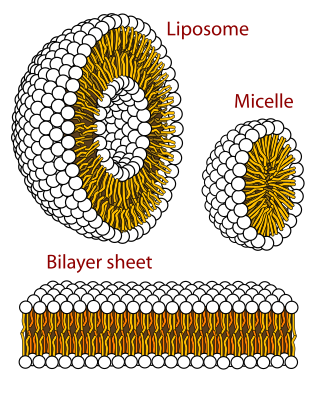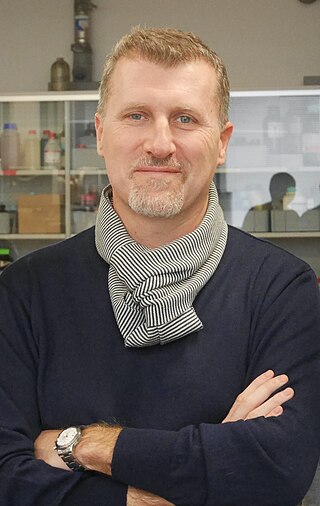Related Research Articles

A colloid is a mixture in which one substance consisting of microscopically dispersed insoluble particles is suspended throughout another substance. Some definitions specify that the particles must be dispersed in a liquid, while others extend the definition to include substances like aerosols and gels. The term colloidal suspension refers unambiguously to the overall mixture. A colloid has a dispersed phase and a continuous phase. The dispersed phase particles have a diameter of approximately 1 nanometre to 1 micrometre.

A micelle or micella is an aggregate of surfactant amphipathic lipid molecules dispersed in a liquid, forming a colloidal suspension. A typical micelle in water forms an aggregate with the hydrophilic "head" regions in contact with surrounding solvent, sequestering the hydrophobic single-tail regions in the micelle centre.

Ferrofluid is a liquid that is attracted to the poles of a magnet. It is a colloidal liquid made of nanoscale ferromagnetic or ferrimagnetic particles suspended in a carrier fluid. Each magnetic particle is thoroughly coated with a surfactant to inhibit clumping. Large ferromagnetic particles can be ripped out of the homogeneous colloidal mixture, forming a separate clump of magnetic dust when exposed to strong magnetic fields. The magnetic attraction of tiny nanoparticles is weak enough that the surfactant's Van der Waals force is sufficient to prevent magnetic clumping or agglomeration. Ferrofluids usually do not retain magnetization in the absence of an externally applied field and thus are often classified as "superparamagnets" rather than ferromagnets.

Soft matter or soft condensed matter is a subfield of condensed matter comprising a variety of physical systems that are deformed or structurally altered by thermal or mechanical stress of the magnitude of thermal fluctuations. These materials share an important common feature in that predominant physical behaviors occur at an energy scale comparable with room temperature thermal energy, and that entropy is considered the dominant factor. At these temperatures, quantum aspects are generally unimportant. Soft materials include liquids, colloids, polymers, foams, gels, granular materials, liquid crystals, flesh, and a number of biomaterials. When soft materials interact favorably with surfaces, they become squashed without an external compressive force. Pierre-Gilles de Gennes, who has been called the "founding father of soft matter," received the Nobel Prize in Physics in 1991 for discovering that methods developed for studying order phenomena in simple systems can be generalized to the more complex cases found in soft matter, in particular, to the behaviors of liquid crystals and polymers.
Electrokinetic phenomena are a family of several different effects that occur in heterogeneous fluids, or in porous bodies filled with fluid, or in a fast flow over a flat surface. The term heterogeneous here means a fluid containing particles. Particles can be solid, liquid or gas bubbles with sizes on the scale of a micrometer or nanometer. There is a common source of all these effects—the so-called interfacial 'double layer' of charges. Influence of an external force on the diffuse layer generates tangential motion of a fluid with respect to an adjacent charged surface. This force might be electric, pressure gradient, concentration gradient, or gravity. In addition, the moving phase might be either continuous fluid or dispersed phase.

The Journal of Colloid and Interface Science is a peer-reviewed scientific journal published by Elsevier. It covers research related to colloid and interface science with a particular focus on colloidal materials and nanomaterials; surfactants and soft matter; adsorption, catalysis and electrochemistry; interfacial processes, capillarity and wetting; biomaterials and nanomedicine; and novel phenomena and techniques. The editor-in-chief is Martin Malmsten. The journal was established in 1946 as Journal of Colloid Science. It obtained its current name in 1966.

Chinedum Osuji is the Eduardo D. Glandt Presidential Professor and the departmental chair of chemical and biomolecular engineering (CBE) at University of Pennsylvania. He is also a former Taekwondo Olympian and represented Trinidad and Tobago. His laboratory works on polymers and soft materials for functional application including liquid filtration. He is the associate editor of the journal Macromolecules.

Monica Olvera de la Cruz is a Mexican born, American and French soft-matter theorist who is the Lawyer Taylor Professor of Materials Science and Engineering and Professor of Chemistry, and by courtesy Professor of Physics and Astronomy and of Chemical and Biological Engineering, at Northwestern University.
David J. Pine is an American physicist who has made contributions in the field of soft matter physics, including studies on colloids, polymers, surfactant systems, and granular materials. He is professor of physics in the NYU College of Arts and Science and chair of the Department of Chemical and Biomolecular Engineering at the NYU Tandon School of Engineering.

Matthew V. Tirrell is an American chemical engineer. In 2011 he became the founding Pritzker Director and dean of the Institute for Molecular Engineering (IME) at the University of Chicago, in addition to serving as senior scientist at Argonne National Laboratory. Tirrell's research specializes in the manipulation and measurement of polymer surface properties, polyelectrolyte complexation, and biomedical nanoparticles.

Steve Granick is an American scientist and educator. In 2023 he joined the University of Massachusetts-Amherst as the Robert Barrett Endowed Chair of Polymer Science and Engineering, with joint appointment in the Chemistry, Physics, and Chemical Engineering Departments after serving as director of the Institute for Basic Science Center for Soft and Living Matter, an interdisciplinary blue-sky research center in Ulsan, South Korea that pursues basic science research. Until 2015 he was professor at the University of Illinois at Urbana-Champaign. He is a member of the American Academy of Arts and Sciences and the U.S. National Academy of Sciences.
Anna Christina Balazs is an American materials scientist and engineer. She currently is Distinguished Professor at the University of Pittsburgh and holds the John A. Swanson Chair at the Swanson School of Engineering.
T. Alan Hatton is the Ralph Landau Professor and the Director of the David H. Koch School of Chemical Engineering Practice at Massachusetts Institute of Technology. As part of the MIT Energy Initiative, he co-directs the Center for Carbon Capture, Utilization and Storage. His work focuses on the development of purification technologies of various kinds for use with air, water, and other substances.
William Bailey Russel was an American chemical engineer, Arthur W. Marks '19 Professor of Chemical Engineering, emeritus, and dean emeritus of the graduate school at Princeton University. He earned his BA and MChE degrees at Rice University in 1969 and his PhD at Stanford University in 1973. He was a NATO Postdoctoral Fellow at Cambridge University in 1974.
Jill Millstone is a professor of chemistry at the University of Pittsburgh. She works on metal-ligand chemistry in nanoparticle synthesis. She is the American Chemical Society Kavli Foundation Emerging Leader in Chemistry Lecturer for 2018.
Ka Yee Christina Lee is Executive Vice President for Strategic Initiatives and the David Lee Shillinglaw Distinguished Service Professor in the Department of Chemistry University of Chicago. She works on membrane biophysics, including protein–lipid interactions, Alzheimer's disease and respiratory distress syndrome. She is a Fellow of the American Institute for Medical and Biological Engineering and American Physical Society.

Rodney Dewayne Priestley is an American chemical engineer and professor at Princeton University. His research considers the phase transitions of polymers and their application in electronic devices and healthcare. In 2020 he was made the Princeton University Vice Dean of Innovation. He was named dean of The Graduate School effective June 1, 2022.

Raffaele Mezzenga is a soft condensed matter scientist, currently heading the Laboratory of Food and Soft Materials at the Swiss Federal Institute of Technology in Zurich. He is among the 0.1% most cited scientists according to the Clarivate 2023 Highly Cited Researchers list in the cross-field discipline.
Ronald G. Larson is George G. Brown Professor of Chemical Engineering and Alfred H. White Distinguished University Professor at the University of Michigan, where he holds joint appointments in macromolecular science and engineering, biomedical engineering, and mechanical engineering. He is internationally recognized for his research contributions to the fields of polymer physics and complex fluid rheology, especially in the development of theory and computational simulations. Notably, Larson and collaborators discovered new types of viscoelastic instabilities for polymer molecules and developed predictive theories for their flow behavior. He has written numerous scientific papers and two books on these subjects, including a 1998 textbook, “The Structure and Rheology of Complex Fluids”.
Shelley Lynn Anna is an American chemical engineer and experimental fluid dynamics researcher who studies droplets, multiphase flow, and the effects of surfactants in microfluidics, the rheology of extensional and interfacial flows, and microscale transport. She is a professor of chemical engineering and associate dean for faculty and graduate affairs and strategic initiatives in the Carnegie Mellon University College of Engineering.
References
- 1 2 3 4 5 6 7 "Sibani Lisa Biswal | Faculty | The People of Rice | Rice University". profiles.rice.edu. Retrieved 2024-03-24.
- 1 2 Biswal, Sibani Lisa (2004). Exploring Novel Structure Formation and Mechanics of Linked Chains of Magnetic Colloidal Particles and their Application in Microfluidics (Ph.D. thesis). Stanford University. OCLC 84408772.
- ↑ "Engineering faculty Biswal, Sabharwal named to endowed chairs | George R. Brown School of Engineering | Rice University". engineering.rice.edu. Retrieved 2024-05-08.
- ↑ "Biswal named associate dean for faculty development | George R. Brown School of Engineering | Rice University". engineering.rice.edu. Retrieved 2024-05-08.
- ↑ "Lisa Biswal: Bioelectronics". Rice University Research Experience for Undergraduates. Retrieved 2024-05-08.
- ↑ "Three from Rice elected fellows of the American Physical Society". Rice News | News and Media Relations | Rice University. Retrieved 2024-03-24.
- ↑ "APS Fellow Archive". www.aps.org. Retrieved 2024-05-08.